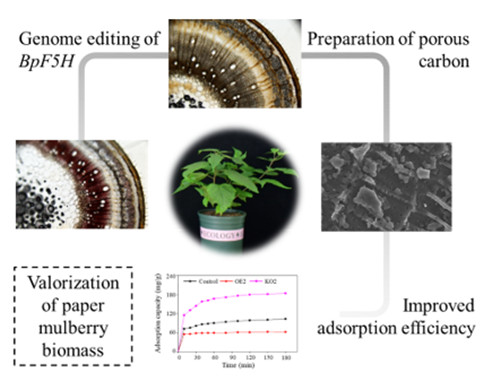Valorization of paper mulberry biomass-based porous carbon material by CRISPR/cas9 mediated genome editing
Paper mulberry (Broussonetia papyrifera) is a rapidly growing perennial woody plant belonging to the Moraceae family. It has a rich history of utilization in traditional Chinese medicine, animal feed, and papermaking. Challenges such as the extended breeding cycle and limited germplasm resources have hindered the breeding progress of paper mulberry. The CRISPR/Cas9-mediated genome editing technology has garnered significant interest in the realm of plant breeding due to its ability to enhance specific plant traits swiftly and precisely. Despite this, the application of genetic editing technology in paper mulberry remains unexplored.
The Crop Molecular Breeding (CMB) research group at QIBEBT, CAS, has been dedicated to advancing and implementing genetic transformation and genome editing technologies in various resource plants. CMB has successfully devised genetic transformation systems for over 20 plants, encompassing herbaceous plants utilized for energy, feed, and ecological rehabilitation, as well as cereal and oil-producing crops, economically valuable forest trees, and traditional Chinese medicinal plants. Additionally, CMB has streamlined an effective and straightforward gene editing technology for alfalfa, resulting in the creation of novel multi-leaf alfalfa germplasm with elevated protein content.
Recently, the team achieved success in developing a transformation and genome editing system for paper mulberry. As a result, genetically modified plants with significantly altered lignin composition were produced. The absorbency performance of porous carbon material derived from the gene-edited paper mulberry surpassed that of unmodified paper mulberry, demonstrating its potential for environmental remediation and pollutant treatment. A study published in Horticulture Research on April 23 initially focused on generating transgenic paper mulberry plants with altered expression of BpF5H. Two transgenic lines (BpF5H_OE1 and BpF5H_OE2) displaying 186- and 158-fold higher F5H expression levels, respectively, along with two biallelic mutation lines (BpF5H_KO1 and BpF5H_KO2), were selected for further analysis. Lignin composition analysis revealed the complete absence of S unit lignin in BpF5H_KO2, indicating a total loss of F5H function.
Porous carbon samples from the control, BpF5H_OE, and BpF5H_KO plants exhibited significant differences in absorption capacity. When subjected to a methyl orange (MO) solution (50 mg/L), the porous carbon derived from BpF5H_KO2 demonstrated nearly twice the absorption capacity of the control sample. These results highlight the potential of F5H as a promising target for developing high-value germplasm. Moreover, genome editing technology exhibits significant potential for expanding the application scope of paper mulberry and other economically important trees.

The valorization of paper mulberry biomass by CRISPR/Cas9 mediated genome editing
(Text/Image by HE Feng)
Contact:
KONG Fengru
Qingdao Institute of Bioenergy and Bioprocess Technology, Chinese Academy of Sciences
Tel: 86-532-58261072
E-mail: kongfr@qibebt.ac.cn